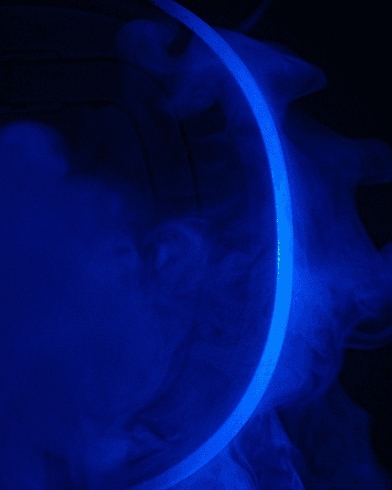Why Neurostimulation Works for Mood Symptoms

I still remember the first time I heard about neurostimulation for mood. As someone who’s not a neuroscientist by training (biochemical engineer over here!), the idea of using a gentle electrical current to lift my spirits sounded almost like science fiction. But once I joined Samphire Neuroscience (after a very early version changed a friend’s life) and began digging into the research, I was amazed to discover how real - and powerful - this approach can be. In this post, I want to share what I’ve learned (in plain English) about why neurostimulation works for mood symptoms. We’ll start with the basics of mood science and depression, then explore how it applies to hormone-related mood conditions like PMS, PMDD, PME, and even endometriosis. Along the way, I’ll share insights from science and lived experiences, and show how it all ties into what we’re doing at Samphire with Nettle™, Lutea™ and our app.
The Brain’s Role in Mood and Depression
When it comes to mood, your brain is the central player. This might sound obvious, but it’s easy to forget that emotions have a biological basis. I certainly didn’t appreciate how concrete this connection was until I started learning about it on the job. Mood disorders like depression aren’t just “in your head” in the dismissive sense - they correspond to real, measurable patterns in brain activity. For example, research shows that depression often goes hand-in-hand with reduced activity in key mood-regulating regions of the brain (like the prefrontal cortex). In anxiety, it’s almost the opposite problem: an overactive fear center in the brain (the amygdala) keeps sounding the alarm even when we’re safe. These patterns help explain why someone with depression can’t simply “cheer up” - parts of their brain are literally under-firing - and why someone with anxiety can’t “just relax” - their threat detectors are cranked up too high. So, not all conditions are visible, and many do primarily exist in the brain, but maybe it’s time to stop saying they’re all in someone’s head, and start saying they’re in someone’s brain (imagine telling someone with a heart attack their problem is “just in their heart”!).
This is where neurostimulation enters the picture. Traditional treatments for mood disorders (like medications or talk therapy) ultimately indirectly try to shift those brain patterns. Neurostimulation, by contrast, works directly on the brain circuits involved in mood. In particular, one form of neurostimulation called transcranial Direct Current Stimulation (tDCS) delivers a tiny, non-invasive electrical current to specific parts of the head to gently nudge the underlying brain activity. If that sounds a bit high-tech, it is - but it’s also a surprisingly simple and safe practice that has been around for more than 30 years. The current is so low-intensity that most people feel just a slight tingling or nothing at all, and there’s no “shock” aspect.
And does it actually help mood? The research and thousands of patients who’ve benefitted from the technology say yes. In fact, a comprehensive 2023 review confirmed that tDCS targeting the prefrontal cortex can significantly reduce depression symptoms and improve emotional regulation. In plain terms, by restoring activity in the brain’s mood-regulating center, people with depression feel less depressed. As someone who started out skeptical, learning about findings like that was a turning point - it transformed neurostimulation from a sci-fi concept to something very tangible and hopeful in my mind.
Hormones and Mood Swings: PMS, PMDD, PME, and More
After grasping how neurostimulation aids mood in conditions like major depression, the logical next step for me was: what about those mood symptoms that so many of us experience around our menstrual cycles? As a woman, I knew firsthand how real and disruptive cyclical mood swings can be. It turns out that women’s mood challenges - especially those tied to hormonal fluctuations - have some unique patterns:
- Women are about twice as likely as men to experience common mood disorders like depression and anxiety.
- Roughly 75% of women experience some form of premenstrual syndrome (PMS) that affects their mood (think irritability, sadness, or anxiety before your period).
- An estimated 3–8% of women suffer from Premenstrual Dysphoric Disorder (PMDD), a severe form of PMS where mood symptoms (depression, hopelessness, rage, etc.) become debilitating.
- Many women with existing mental health conditions experience premenstrual exacerbation (PME) – in other words, their underlying depression or anxiety gets dramatically worse in the week or two before menstruation. (One estimate suggests that about 40% of women seeking help for “PMDD” actually fall in this PME category)
- Women with endometriosis - a condition known for chronic pelvic pain - also frequently grapple with mood disorders. In one study, a staggering 86% of endometriosis patients with chronic pain had clinical depression, compared to 38% of patients without chronic pain.
Those numbers aren’t just statistics to me - they represent real women and real suffering. And for a long time, these issues haven’t been adequately addressed. Incredibly, until the 1990s most clinical trials excluded women, meaning women’s unique physiology was often an afterthought in the development of mood treatments. No wonder so many of us have felt like we had to just “deal with” mood swings as an inevitability of being female.
Fortunately, science is finally shining a light on what’s actually happening in our brains during these hormone-related mood shifts. The big revelation is this: our hormones might be the triggers, but the brain’s response to those hormones is what drives mood symptoms. You can have completely normal levels of estrogen and progesterone, yet if your brain is extra sensitive to their monthly rise and fall, you might experience anxiety, depression, or rage that another person with the same hormone levels doesn’t. In PMDD, for example, women aren’t producing abnormal hormones - instead, their brains react differently to normal hormonal changes. Researchers demonstrated this by suppressing and adding back hormones: when you temporarily halt ovarian hormone fluctuations (using medication), women with PMDD see their mood symptoms vanish; but once normal hormonal cycling is reintroduced, the symptoms come right back. The brain is where the disconnect lies.
What about the brain itself during the menstrual cycle? Fascinating studies have shown that the female brain actually undergoes measurable structural and functional changes across the cycle, influenced by shifting hormone levels. These changes can directly affect mood, as well as cognition and pain perception. It’s a monthly dance of chemistry and neurology. For those of us who experience mood issues with our cycles, it often feels like something in my head just flips during that luteal phase (the week or so before the period) - and in a way, that’s true. The stage is set for mood symptoms when certain brain networks get thrown off balance by hormonal signals.
A Brain-First Approach to Hormonal Mood Symptoms
Understanding the above was a “lightbulb moment” for me. If the brain’s handling of hormone signals is the real culprit behind these mood swings, then helping the brain adapt should provide relief - without needing to flood the body with drugs or extra hormones. This is precisely where neurostimulation offers a game-changing, brain-first approach.
Instead of taking medication that tries to mask the symptoms or override your hormones, neurostimulation works with your body’s natural systems to recalibrate your mood. How? By directly modulating the neural circuits that regulate emotion and receive hormonal signals. For instance, gentle tDCS can be used to stimulate the prefrontal cortex, strengthening your brain’s top-down calming influence, while also soothing hyperactive stress or pain centers. Essentially, we’re telling the brain, “It’s okay, you can dial it down,” right at the source where the hormonal chaos is being interpreted.
One way I like to think of it is as noise-cancelling headphones for your brain. Hormonal fluctuations might be creating a lot of “noise” in the form of erratic neural activity, and neurostimulation helps quiet that noise so your mood remains steady. Importantly, this isn’t about shutting off your natural cycle - it’s about helping your brain cope with the cycle more smoothly without interfering with the hormones that govern it. You’re still you, just a calmer, clearer version of you even when hormones are bouncing around.
I’ve had the privilege to see this approach help real people. In fact, one user with a history of PMDD (and even ADHD) shared that using Nettle “helped immensely,” reducing the symptoms of both conditions. I’ve also spoken to hundreds of other users and seen some of them share their experiences publicly on platforms like Trustpilot. Hearing feedback like that is incredibly validating - it means we’re on the right track by targeting the brain. And beyond immediate relief, there’s a long-term benefit: neurostimulation leverages neuroplasticity, the brain’s ability to form new, healthier connections. Over time, repeated sessions can train your brain to respond more adaptively to hormonal changes even when it’s not receiving stimulation. (Neuroscientists often say “neurons that fire together, wire together,” and that’s the goal - to wire in more stable mood pathways.) So we’re not just putting out fires momentarily; we’re helping prevent the fire from catching as easily next cycle. This means you could see improvements accumulate month over month.
Samphire’s Mission: Bringing Brain-Based Wellness to Women’s Mood
All of this science and experience funnels into the mission that brought me to Samphire Neuroscience in the first place. I joined Samphire because I believe in a future where women (and anyone with cycles) don’t have to feel at the mercy of their mood swings or pain. Our mantra is that you should be able to feel your best in every phase of your cycle, and we see the brain as key to making that happen.
That mission has taken shape in the form of our solutions, Nettle™ and Lutea™. Nettle™ is a small, wearable tDCS device - essentially a brain-stimulating headset – designed specifically to relieve menstrual-related mood and pain symptoms in a drug-free, hormone-free way. It’s safety and efficacy have been tested in randomized, sham controlled trials (the gold standard) and approved by regulators in the UK and EU. You wear Nettle™ for about 20 minutes a day, typically during the luteal phase when you’re prone to PMS or PMDD symptoms, and it delivers targeted low-intensity currents to the regions of your brain that need support. It’s based on decades of neurostimulation research but tailored to work with women’s unique hormonal rhythms. By using it consistently (five days per cycle, in clinical trials), users are effectively training their brains each month to not overreact to the hormone tsunami. And as the research predicted, many are feeling notably better – clearer, calmer, and more in control throughout their cycles.
Lutea™ brings the same research-backed tDCS technology into a beautifully simple, everyday form - globally. It’s designed for anyone looking to support calm, clarity, and balance across the entire cycle, not just in the days when symptoms spike. Think of it as Nettle™’s lifestyle-first sibling - still grounded in neuroscience, but accessible as a wellness tool no matter where you are in the world. It’s gentle, drug-free, and designed to help your brain stay steady, whatever your hormones are up to.
Hand-in-hand with Nettle™, we developed the Samphire app as a personal “cycle companion for your cycle”. The app isn’t just a period tracker (though it does track your cycle); it’s about connecting the dots between your brain, your hormones, and how you feel. It uses your input to help predict when you might feel a dip in mood or a spike in pain, so you’re never blindsided. It also provides guided exercises (like breathwork and meditation) to reinforce that neuroplasticity we talked about, and it gives you data to discuss with healthcare providers. The idea is to empower you with insights about your own body and brain - turning what used to be an unpredictable rollercoaster into a pattern you can anticipate and proactively manage.
Speaking personally, being part of this brain-first approach to women’s health has been eye-opening. I’ve learned more neuroscience in this role than I ever did at school or university, and I’ve applied much of it to my own life. (Yes, I use Nettle™ and Samphire myself - and yes, they’ve made a difference for me!) I’ve also had countless conversations with women who felt unheard or unsatisfied with the “take some ibuprofen and try birth control” standard answers. There’s something profoundly empowering about validating their experiences with real science, then offering a solution that doesn’t require them to sacrifice their natural cycle or put up with sedating side effects.
Our mission at Samphire is to continue pushing this innovation forward – to make advanced neurotechnology as commonplace and accessible as Tylenol or a meditation app for anyone who needs it, and give women options where they had none. We’re collaborating with researchers and conducting clinical studies to keep building evidence for this approach. The hope is that one day, when a young woman says “My mood is wrecked every month,” the response from the medical community will be, “Here’s a proven brain-based tool you can use,” rather than, “That’s just part of being a woman.” We’re not quite there yet everywhere, but we’re working on it.
I’m excited to continue on this journey, both as a learner and as someone helping translate this science into real-world care. If you’ve made it this far, thank you - it means a lot to me to be able to share these discoveries. I truly believe this brain-first perspective is going to change lives (mine included). And if it spares even a few people those days of feeling hopeless or unlike themselves, then every bit of effort is worth it. Here’s to a future where mood no longer owns us - because we’ve learned how to harness the power of our own brains to feel well, no matter the phase we’re in.
Related Articles

Women with severe PMS and PMDD experience depression-like symptoms every month
An increasing number of clinical studies are examining the brain in relation to the menstrual cycle, with a particular focus on women with severe PMS

The Future of Neurotechnology in Mental Health: What's Coming for Women's Wellness
Neurotechnology is reshaping mental health care especially for women. This guide explores how non-invasive brain stimulation, wearables like Nettle™ and Lutea™, and personalized neurotech are redefining treatment for anxiety, depression, and PMDD. Learn how brain-first, hormone-free solutions harness neuroplasticity to support calm, focus, and emotional balance safely and effectively.

We asked Nettle™ users about their experience - here’s what they said
Real women, real results. After six months with Nettle™, users reported fewer sick days, less reliance on medication, and reduced GP visits. 80% said they regained nearly a month of life each year, 9 in 10 changed how they use painkillers or hormones, and over half wish GPs offered Nettle™ first. Proof that menstrual health can mean fewer pills, fewer appointments - and more control.